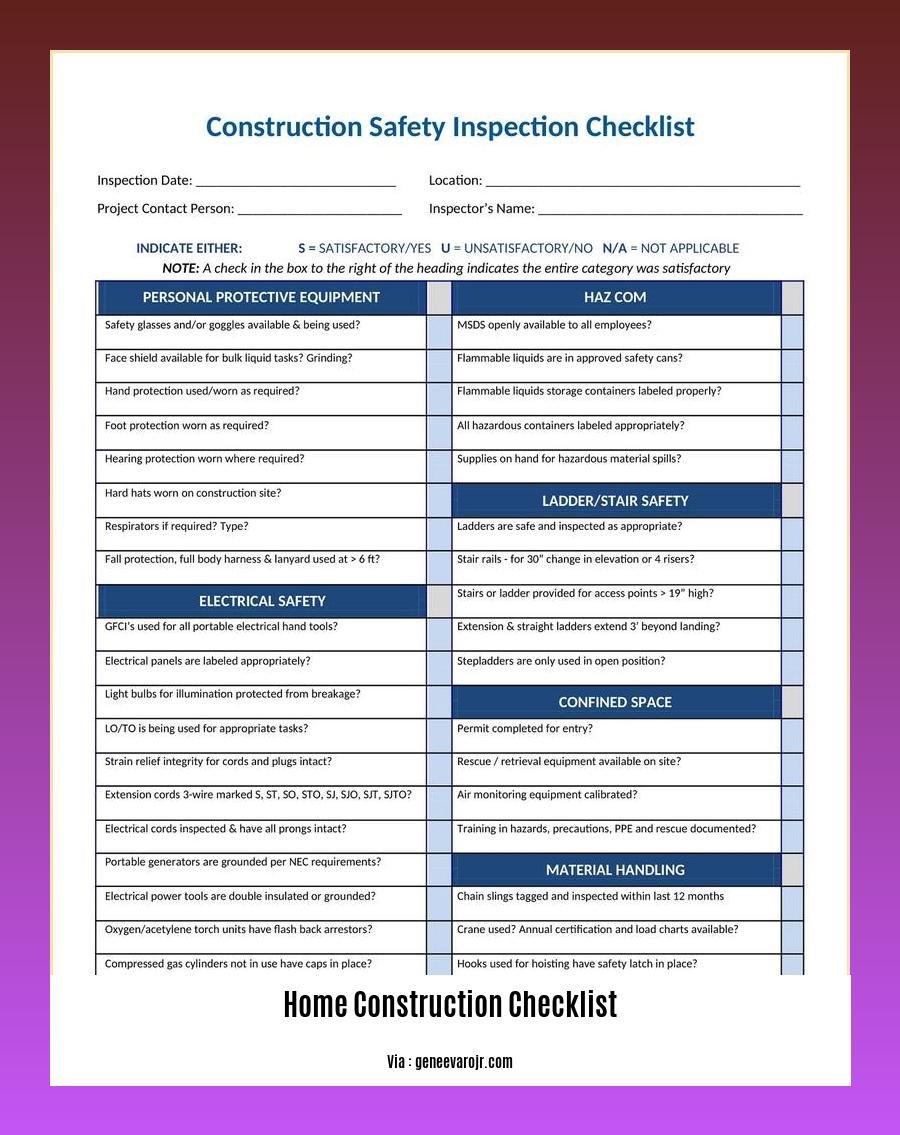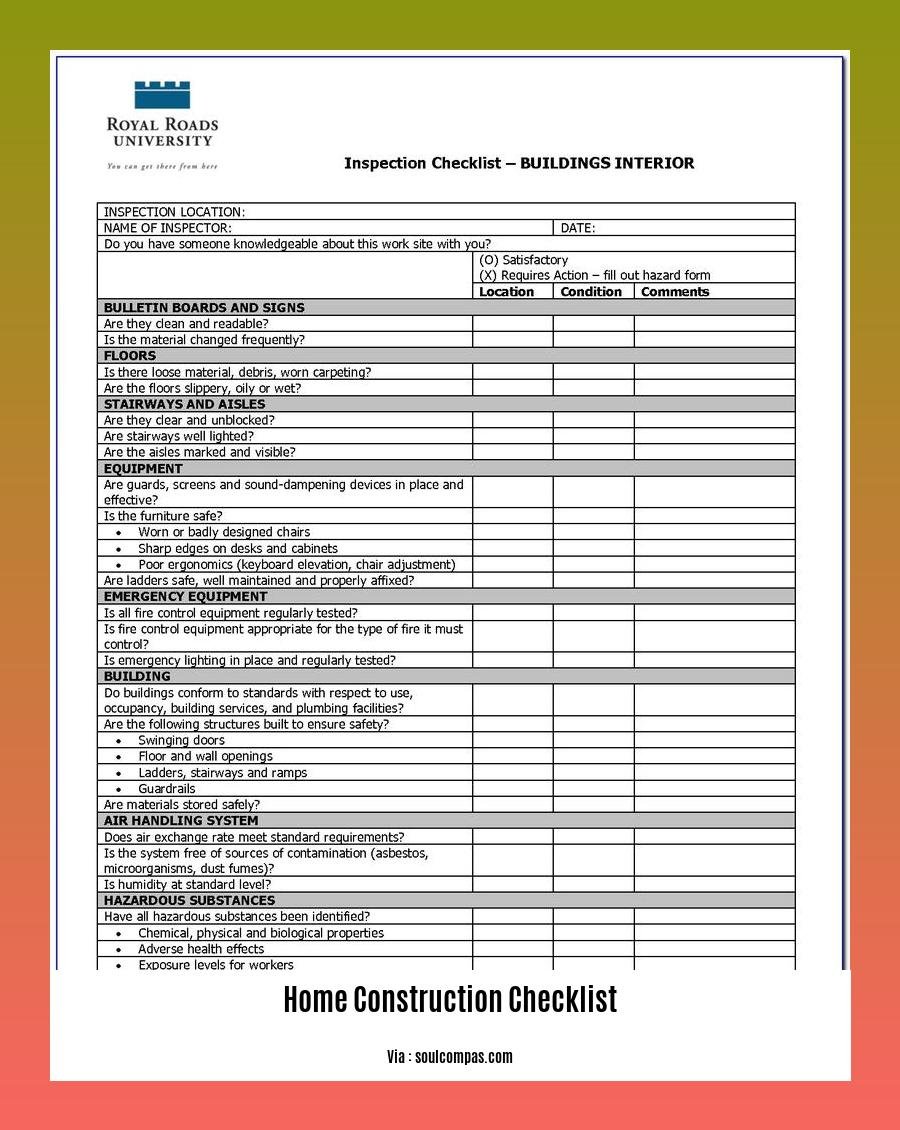Embark on your home construction journey with confidence and ease with our comprehensive checklist – [The Ultimate Home Construction Checklist: A Step-by-Step Guide for Building Your Dream Home].
Key Takeaways:
- Building a home is a sizable financial undertaking.
- Financing must be in place before starting construction.
- Buying land directly from a builder is a viable option.
- A precise timeline is essential, but unexpected delays may occur.
- Working with experienced builders streamlines the building process.
- Customization options are available during the design phase.
- It’s crucial to avoid overly restrictive timelines as they can hinder progress.
- Refer to the “Building Checklist Templates” and “Importance of a Home Building Checklist” resources for additional guidance.
Home Construction Checklist

So, you’re ready to embark on the journey of building your dream home. Fantastic! To ensure a smooth and successful process, let’s dive into a comprehensive home construction checklist that covers every crucial step:
1. Secure Financing
Get pre-approved for a mortgage before purchasing land, as it determines the budget for your home construction project.
2. Purchase Land
Scout for a suitable plot of land that aligns with your vision and budget. Consider accessibility, utilities, and zoning regulations.
3. Design and Plan
Collaborate with an architect or builder to create blueprints and design plans. This stage involves selecting materials, determining the layout, and obtaining building permits.
4. Set a Timeline
Establish a realistic timeline for the construction process, considering delays due to weather or unforeseen circumstances.
5. Material Procurement
Plan for timely sourcing of quality building materials. This includes ordering windows, doors, appliances, and fixtures.
6. Site Preparation
Clear the land, grade it, and establish a solid foundation. This stage sets the groundwork for a sturdy and durable home.
7. Framing and Structure
Erect the skeletal structure of your home, including walls, floors, and roof. Ensure adherence to building codes for safety and stability.
8. Utilities Installation
Install electrical wiring, plumbing systems, heating and cooling units, ensuring they meet safety standards and provide comfort.
9. Interior Finishes
Choose your flooring, cabinetry, countertops, and paint colors. This is where your home starts to take shape and reflect your style.
10. Exterior Finishes
Select roofing materials, siding, and landscaping to enhance the curb appeal and protect your home from the elements.
11. Inspection and Completion
Schedule regular inspections throughout the construction process. This ensures adherence to plans, codes, and quality standards. Finally, obtain a certificate of occupancy once the construction is complete.
12. Move-In and Enjoy
Celebrate the completion of your dream home! Move in and enjoy the fruits of your labor. Don’t forget to create a maintenance plan for the years to come.
If you reside in an area where you experience a lot of rainfall, you must prioritize protecting your home from water damage. Home construction advice is essential for homeownership, especially if you want your home to be secure, comfortable, and last a long time.
In Pakistan, many reputable home construction companies in Lahore are known for their commitment to detail and craftsmanship. If you are planning to construct a home in Sri Lanka, it is important to familiarize yourself with various home construction companies in Sri Lanka. For those residing in Delhi, there are many reliable home construction company in Delhi that specialize in building custom homes tailored to your needs and preferences.
Execute Construction

Are you embarking on the exciting journey of building your dream home? If so, you’ve come to the right place. As an experienced home builder, I’ll serve as your guide through every step of the Execute Construction phase.
Key Takeaway:
- Acquire a building permit.
- Prepare the building site.
- Construct the foundation and framing.
- Install utilities and finishes.
- Complete a final inspection.
1. Acquire a Building Permit:
Before breaking ground, secure a building permit from your local authorities. This involves submitting plans and obtaining approval, ensuring your project meets safety and building codes.
2. Prepare the Building Site:
Clear the building site, establish property lines, and prepare the ground for construction. This may involve grading, excavating, and installing utilities.
3. Construct the Foundation and Framing:
Build the home’s foundation, typically consisting of concrete footings and a poured slab. Erect the framing, including walls, floors, and roof, forming the structural skeleton of the house.
4. Install Utilities and Finishes:
Install electrical, plumbing, and HVAC systems. Add insulation, drywall, flooring, and other interior finishes to create a comfortable and livable space. Complete exterior finishes such as siding, roofing, and windows.
5. Complete a Final Inspection:
Once construction is complete, a final inspection is conducted by a qualified inspector. This ensures the home meets building codes and is safe for occupancy. Upon passing inspection, you can receive a certificate of occupancy and move into your dream home.
URL Sources:
- Building Permit Process: A Step-by-Step Guide
- Home Construction Timeline: A Month-by-Month Guide
Conducting Project Inspections
As an expert in home construction, conducting project inspections is a vital part of ensuring your new home meets the highest standards. By thoroughly checking each aspect of the project, you can identify potential issues early on and prevent them from escalating into major problems. Here’s a comprehensive guide to help you conduct effective project inspections:
Key Takeaways:
- Safety comes first: Prioritizing safety and following regulations is crucial.
- Maintain quality: Verify that the construction adheres to plans and specifications.
- Document everything: Record findings and deviations to monitor progress and ensure accountability.
- Continuously improve: Use inspections to identify areas for improvement and enhance project efficiency.
Step-by-Step Process:
1. Plan and Schedule Inspections:
– Inspections should be conducted regularly throughout the construction process.
– Inspections should be planned in advance and scheduled with all relevant parties.
2. Create a Site-Specific Checklist:
– Develop a checklist that outlines the specific items to be inspected.
– This checklist should be based on the project plans and specifications.
3. Assign Roles and Responsibilities:
– Clearly define the roles and responsibilities of all parties involved in the inspection.
– This includes the inspector, project manager, and any subcontractors.
4. Inspect Thoroughly:
– Follow the checklist and pay attention to every detail.
– Check for any deviations from the project plans and identify potential risks.
– Use measuring tools and other equipment to ensure accuracy.
5. Document Findings:
– Record all findings, including observations, measurements, and photographs.
– Use a digital or paper-based inspection report for proper documentation.
6. Communicate Findings:
– Communicate findings to the project manager and other relevant parties.
– Use clear and concise language to describe any issues or concerns.
7. Address Issues Promptly:
– Work with the project manager to develop and implement corrective actions for any identified issues.
– Prioritizing safety should be of the essence, and actions should be taken swiftly to mitigate risks.
8. Verify Resolutions:
– Once corrective actions have been implemented, verify that the issues have been resolved.
– Additional inspections may be necessary to ensure compliance.
9. Continuous Monitoring:
– Regularly monitor the project’s progress and conduct additional inspections as needed.
– This will help ensure that the project remains on track and meets the desired quality standards.
Conclusion:
Conducting thorough project inspections is a critical aspect of ensuring the success of your home construction project. By following the steps outlined in this guide, you can identify issues, maintain quality, and create a safe and beautiful home that meets your expectations.
Finalize
Now that your home is complete, it’s time to finalize the project. This includes obtaining a certificate of occupancy, conducting a final walkthrough, and addressing any outstanding issues.
Key Takeaways:
- Obtain a certificate of occupancy from the city or county.
- Conduct a final walkthrough with your contractor to inspect the work and address any concerns.
- Review all warranties and service contracts for your home and appliances.
- Create a punch list of any remaining items that need to be completed.
- Contact your insurance company to set up homeowners insurance.
Sources:
- How to Finalize a Home Construction Project
- Finalizing Your New Home Construction
FAQ
Q1: What is the first step in creating a home construction checklist?
A1: The first step is to determine your budget, as this will significantly impact the scope and feasibility of your project.
Q2: How can I ensure that my home construction project stays on track?
A2: By creating a detailed plan, outlining the project’s timeline, and setting realistic milestones, you can significantly improve the chances of staying on schedule.
Q3: What factors should I consider when choosing a contractor for my home construction project?
A3: Look for licensed and insured contractors with a proven track record of delivering high-quality work within your budget and timeline constraints.
Q4: How can I manage changes or unexpected events during the home construction process?
A4: Establish a change order process and incorporate a contingency fund into your budget to anticipate and address potential changes during construction.
Q5: What is the importance of regular inspections during the home construction process?
A5: Regular inspections allow you to monitor progress, identify potential issues early on, and ensure that the construction meets the agreed-upon plans and quality standards.
- Black Backsplash Tile: Find The Perfect Style For Your Kitchen - November 6, 2025
- Black Backsplash With White Cabinets: A Bold Kitchen Design - November 5, 2025
- Black and White Kitchen Backsplash: Ideas for Timeless Style - November 4, 2025










